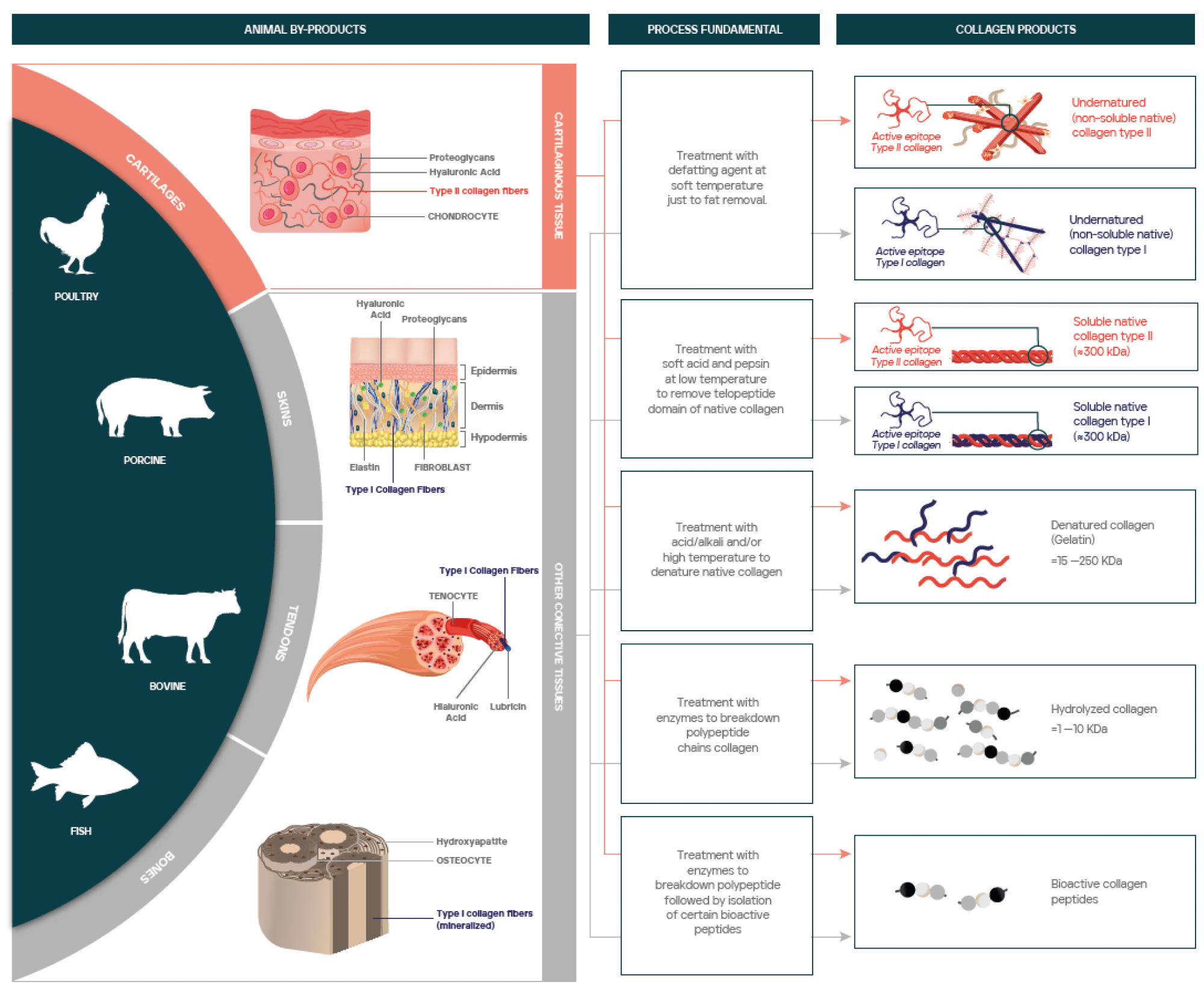Introduction
Types and sources of collagen
Absorption and bioavailability
Mechanisms of action
Clinical evidence
Safety, dosing, and regulation
Limitations and controversies
Conclusions and future directions
References
Further reading
Take a closer look at the promising benefits and persistent controversies of collagen supplementation, including what’s proven, what’s emerging, and what remains uncertain.
 Image Credit: Katarzyna Hurova / Shutterstock.com
Image Credit: Katarzyna Hurova / Shutterstock.com
Introduction
Collagen accounts for up to 30% of total human protein mass while dominating connective tissues such as skin, cartilage, tendon, and bone. As endogenous collagen production levels decline with age and injury, hydrolyzed collagen peptide supplements have become increasingly popular across dermatology, sports medicine, and joint‑health programs1,2.
This article summarizes collagen supplements, absorption, mechanisms, clinical benefits for skin, joints, and muscles, dosage guidance, safety considerations, and emerging medical applications. Recent evidence also highlights potential benefits for mental well-being and quality of life, especially in aging, active adults8,9.
Types and sources of collagen
Type I collagen strengthens bone, skin, tendons, and teeth, whereas Type II provides support for articular cartilage. Type III collagen preserves elasticity in the dermis, muscle, and vessels1.
Raw collagen material is primarily obtained from bovine hides and porcine skin because their fibrils are abundant and resemble human collagen. Marine fish skins, poultry waste, and ovine tissues offer sustainable alternatives that utilize by‑products2. Recent product innovations include recombinant and vegan collagen, though their efficacy is less well established.7
Gelatin, which is produced by partial denaturation, retains long polypeptide chains that form thermo‑reversible gels. Further enzymatic hydrolysis cleaves these chains into hydrolyzed collagen, which is highly soluble in water, exhibits low viscosity, and rapidly passes through the intestinal wall. These small peptides disperse easily in beverages, nutraceuticals, and biomedical matrices to deliver higher bioavailability and cost‑effective doses than native collagen or gelatin2. The exact sequence, molecular weight, and amino acid profile may influence absorption and outcomes6.
Absorption and bioavailability
Oral collagen hydrolysates (CH) are fragmented by gastric and pancreatic enzymes into free amino acids and short peptides. Thereafter, enterocytes use the proton‑coupled oligopeptide transporter‑1 (PepT1) to transport di‑ and tri‑peptides, particularly proline‑hydroxyproline (Pro‑Hyp), across the intestinal border, whereas residual peptides are further hydrolyzed to amino acids3.
In humans, a single 10 g CH dose increases plasma free hydroxyproline by seven‑ to ten‑fold and introduces measurable Pro‑Hyp, hydroxyproline‑glycine (Hyp‑Gly), and related peptides. Pro‑Hyp rapidly became the dominant circulating species despite its low content in the supplement.
This observation suggests preferential liberation and high stability, both of which can enhance delivery to collagen‑rich tissues such as skin, cartilage, and bone3. Pairing CH with antioxidant nutrients like vitamin C can also stabilize peptides and amplify fibroblast responses to enhance tissue targeting3.
Processing conditions, molecular weight, raw‑material origin, genetic variability, gut microbiome composition, and mucosal health influence digestion kinetics and transporter activity. Age‑associated reductions in enzyme secretion and intestinal surface area can also reduce collagen uptake.
Mechanisms of action
Collagen functions as a primary scaffold of the extracellular matrix while simultaneously providing mechanical and biochemical signals needed to initiate tissue regeneration. Intact or hydrolyzed fibrils provide integrin‑rich binding sites, which facilitate the spread of fibroblasts needed for matrix deposition and remodeling1,4.
Once absorbed, di‑ and tri‑peptides reach the dermis and cartilage to stimulate fibroblast proliferation, increase type I and type III procollagen messenger ribonucleic acid (mRNA) levels, as well as support hyaluronic acid and decorin production to restore tensile strength and hydration. Taken together, these effects allow collagen supplementation to potentially increase bone mineral density, cartilage volume, and skin elasticity1,4.
Hydrolyzed collagen acts primarily by supplying bioactive peptides and amino acids, while undenatured (native) type II collagen may work via immune-mediated oral tolerance mechanisms at the joint10. The mechanisms of action for collagen supplementation are not yet fully elucidated, and more research is needed10.
Collagen peptides also may reduce inflammation and oxidative stress that erode connective tissues by suppressing tumor necrosis factor α (TNF-α) and interleukin‑6 (IL-6) release. In particular, glycine-rich collagen preserves decorin and antioxidant activities while simultaneously protecting the extracellular matrix from proteolytic and free‑radical injury1,4.
Clinical evidence
Randomized controlled trials (RCTs) and meta-analyses suggest that oral collagen peptides improve skin, joint, bone, and muscle outcomes1,2,4. For example, a meta-analysis of 19 studies and 1,124 adults reported that 60-90 days of collagen supplementation increased elasticity and density while simultaneously reducing wrinkle depth. Improvements in skin hydration and elasticity are generally modest but statistically significant, particularly in older adults6,7,.
 Overview of main collagen products that can be obtained from natural sources (animal by-products) according to their origin (animal and tissue) and manufacturing process. Hydrolyzed collagens can be obtained from cartilage or other connective tissues through an enzymatic treatment to breakdown polypeptide chains. Undenatured (non-soluble) or soluble native collagen type II can be only obtained from cartilage, through soft temperature processes to maintain the triple helix structure intact.9
Overview of main collagen products that can be obtained from natural sources (animal by-products) according to their origin (animal and tissue) and manufacturing process. Hydrolyzed collagens can be obtained from cartilage or other connective tissues through an enzymatic treatment to breakdown polypeptide chains. Undenatured (non-soluble) or soluble native collagen type II can be only obtained from cartilage, through soft temperature processes to maintain the triple helix structure intact.9
Orthopedic evidence suggests that collagen supplementation provides clinically relevant pain relief and structural preservation. Multiple double‑blind trials reported lower Visual Analog and Western Ontario and McMaster Universities Arthritis Index (WOMAC) scores and stiffness, as well as superior mobility, as compared to the placebo. Imaging and biomarker studies have similarly recorded larger cartilage volumes and higher spinal or femoral bone mineral density after consuming between five and 10 g/day, especially in post‑menopausal women1. For osteoarthritis, evidence is mixed, with some studies finding meaningful reductions in pain and improvement in joint function, while others report limited or placebo-level effects10.
Both hydrolyzed collagen and undenatured type II collagen have been studied, with undenatured forms acting through immune-mediated pathways and hydrolyzed forms supplying bioactive peptides10.
Four double‑blind RCTs using 15 g/day of collagen, in addition to resistance training, led to significant improvements in lean mass and strength while reducing fat mass. Similar results were reported during a 48‑week study, as only five g/day of collagen increased both spinal and femoral‑neck density1.
Benefits are most consistent when collagen supplementation is combined with regular resistance or physical training, and when used for at least 3–6 months. Some recent studies also show improvements in mental health and quality of life measures, especially at doses of 10–20g/day in active middle-aged adults. However, the magnitude of benefit varies by product, dose, and population, and some studies show little difference from placebo8,9.
Collectively, these benefits were observed between eight and 16 weeks after treatment initiation, with doses ranging from 2.5 g/day up to 15 g/day. These findings support collagen peptides as a potentially safe adjunct for skin rejuvenation, osteoarthritis management, bone support, and muscular recovery1.
Safety, dosing, and regulation
In the United States, collagen products are classified as dietary supplements under the Dietary Supplement Health and Education Act. As a result, manufacturers are responsible for pre‑market safety substantiation, while the Food and Drug Administration (FDA) enforces good‑manufacturing‑practice inspections, product sampling, and adverse‑event investigations.
In the European Union, collagen products are considered food supplements, which are regulated by the European Food Safety Authority (EFSA). Dossiers submitted under Directive 2002/46/EC must document composition, allergens, and contaminant limits before market entry5.
Although both regions apply hazard analysis and good manufacturing practice requirements, pre‑market review is more stringent in the European Union. This lack of harmonization emphasizes the crucial need for international cooperation and global standards to protect consumers and support trade5.
Collagen supplements are generally well-tolerated, with mild gastrointestinal symptoms, allergic reactions, or taste disturbances rarely reported. Those with allergies to fish, bovine, porcine, or avian proteins should avoid products from those sources. Not recommended in pregnancy or breastfeeding due to insufficient safety data9.
Limitations and controversies
Collagen supplements vary widely in source, peptide length, and added nutrients. For example, marine collagens have lower thermal stability and mechanical strength than bovine preparations. Moreover, diverse commercial blends combine multiple collagen types and concentrations, which increases the difficulty of comparing batch purity and confidently assessing dose‑response relationships6.
Safety profiles also differ, as marine products can provoke shellfish reactions, whereas bovine gelatin may carry a prion‑transmission risk. Although several randomized placebo‑controlled trials report improvements in skin hydration, muscle mass, or joint comfort, many of these benefits are modest and sometimes match placebo outcomes6, 9,10.
To date, most studies examining the health effects of collagen supplementation have enrolled small cohorts, used proprietary formulations, and have been conducted for a total duration of twelve to twenty‑four weeks. As a result, larger and standardized trials with extended follow‑up periods should be undertaken to clarify optimal dosing and the durability of effects8,9.
The clinical significance of reported benefits remains debated, and many effects are modest. Further large, standardized, and longer-duration studies are needed to define optimal dosing, long-term safety, and real-world effectiveness8,9.
Importantly, any perceived benefit associated with collagen supplementation may reflect increased protein intake or expectation bias, rather than specific stimulation of endogenous collagen metabolism. Resolving these issues will require direct‑comparison studies that monitor biochemical markers and clinical outcomes over multiple years9.
Are collagen supplements worth the hype?
Conclusions and future directions
Accumulating evidence from short-term studies demonstrates that oral collagen peptides may improve skin elasticity, joint comfort, bone mineral density, and muscle recovery in people with age- or disease-related deficits. Future applications of collagen supplementation may include regenerative medicine, where collagen-based scaffolds seed cartilage and bone repair, as well as personalized nutrition, in which peptide profiles are adjusted to genomic and microbiome signatures.1,4
References
- Campos, L. D., Junior, V. D. A. S., Pimentel, J. D., Carregã, G. L. F., & Cazarin, C. B. B. (2023). Collagen supplementation in skin and orthopedic diseases: A review of the literature. Heliyon, 9(4). DOI:10.1016/j.heliyon.2023.e14961, https://www.sciencedirect.com/science/article/pii/S2405844023021680
- León-López, A., Morales-Peñaloza, A., Martínez-Juárez, V. M., Vargas-Torres, A., Zeugolis, D. I., & Aguirre-Álvarez, G. (2019). Hydrolyzed Collagen—Sources and Applications. Molecules, 24(22). DOI:10.3390/molecules24224031, https://www.mdpi.com/1420-3049/24/22/4031
- Virgilio N, Schön C, Mödinger Y, van der Steen B, Vleminckx S, van Holthoon FL, Kleinnijenhuis AJ, Silva CIF and Prawitt J (2024) Absorption of bioactive peptides following collagen hydrolysate intake: a randomized, double-blind crossover study in healthy individuals. Front. Nutr. 11. DOI:10.3389/fnut.2024.1416643, https://www.frontiersin.org/journals/nutrition/articles/10.3389/fnut.2024.1416643/full
- Cole, M. A., Quan, T., Voorhees, J. J., & Fisher, G. J. (2018). Extracellular matrix regulation of fibroblast function: redefining our perspective on skin aging. Journal of cell communication and signaling, 12(1), 35-43. DOI:10.1007/s12079-018-0459-1, https://link.springer.com/article/10.1007/s12079-018-0459-1
- Shan, F., Liu, L., Li, L., Wang, W., Bi, Y. and Li, M. (2025), Management, Safety, and Efficacy Evaluation of Nutraceutical and Functional Food: A Global Perspective. Compr Rev Food Sci Food Saf., 24 (4). DOI:10.1111/1541-4337.70222, https://ift.onlinelibrary.wiley.com/doi/abs/10.1111/1541-4337.70222
- Wang, H. (2021). A review of the effects of collagen treatment in clinical studies. Polymers, 13(22). DOI:10.3390/polym13223868, https://www.mdpi.com/2073-4360/13/22/3868
- Martini Nataly (2019) Collagen supplements. Journal of Primary Health Care 11, 385-386. DOI:10.1071/HC15947, https://www.publish.csiro.au/hc/fulltext/HC15947
- Shiloah A. Kviatkovsky, Robert C. Hickner, Hannah E. Cabre, Stephanie D. Small & Michael J. Ormsbee (2023) Collagen peptides supplementation improves function, pain, and physical and mental outcomes in active adults, Journal of the International Society of Sports Nutrition, 20:1, 2243252, DOI: 10.1080/15502783.2023.2243252, https://www.tandfonline.com/doi/full/10.1080/15502783.2023.2243252
- Collagen Supplementation for Joint Health: The Link between Composition and Scientific Knowledge. Nutrients, 15(6), 1332. DOI:10.3390/nu15061332, https://www.mdpi.com/2072-6643/15/6/1332
- Inácio, P. A., Gomes, Y. S., De Aguiar, A. J., Leonardo, P. S., Aimbire, F., Leonardo, P. S., Sá Filho, A. S., & B., R. A. (2023). The Effects of Collagen Peptides as a Dietary Supplement on Muscle Damage Recovery and Fatigue Responses: An Integrative Review. Nutrients, 16(19), 3403. DOI:10.3390/nu16193403, https://www.mdpi.com/2072-6643/16/19/3403
Further Reading
Last Updated: Jul 29, 2025